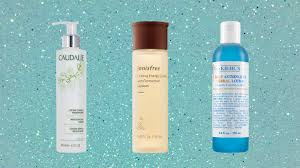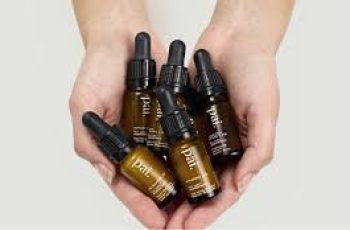What is an astringent? How is it different from a toner?
Have you noticed that your moisturizer isn’t absorbing as quickly as it used to? You feel like your skin is missing something, but you can’t quite put your finger on what it is. An astringent might be the answer you’ve been looking for. Learn more about this skin-changing product here.
What is an astringent?
An astringent is a liquid formula, usually containing rubbing alcohol (isopropyl alcohol), that oily skin types use to cleanse the skin, tighten pores, and dry out excess sebum that can cause blemishes. Applying an astringent after cleansing cleanses the skin and prepares it for moisturizing. This can be a very valuable step in your skin care routine. The name itself comes from the Latin word astringere, which means “fast-binding,” giving you an idea of how quickly the product works. It comes in many different formulas with extra ingredients that can help with a variety of skin concerns, from redness and blemishes to dull complexion.
For those who are familiar, the product may sound very similar to toner. Although astringents are used in the same way, there are many differences between the two, which we’ll discuss further!
What are the benefits of using an astringent?
Astringents have many benefits for the skin, such as:
Astringents tighten the skin
Astringents reduce inflammation
Astringents reduce the formation of skin blemishes, such as pimples and blackheads
Astringents cleanse the skin of irritants
Astringents shrink large pores
Astringents are antibacterial
Astringents open pores
Astringents remove excess oil (sebum)
Oily and acne-prone skin are the skin types that benefit the most from astringents. But that doesn’t mean you should skip the product if you have normal or dry skin, because the selection is impressive and finding an astringent or toner is easier than you think. With natural astringents like witch hazel and lemon, you’ll find the best formulas for removing makeup residue or the day’s residue from your skin.
How to Use an Astringent
Astringents are the next step after cleansing and before serum or moisturizer. Many astringents contain chemical exfoliants like salicylic acid and citric acid, which can penetrate deep into the skin to unclog bacteria-clogged pores and remove any product or makeup that your cleanser may have missed.
Step 1 – Cleansing
No matter which cleanser you choose, it must always be the first step in your routine to ensure your skin is as clean as possible. Cleansers can remove some of your makeup and other products. It can also loosen up dead skin cells that build up on your skin and cause dry spots, blemishes, and blackheads.
Step 2 – Astringent or Toner
Dip a cotton pad in the liquid of your choice and wipe it over your skin, avoiding your eyes and mouth. When you examine it afterwards, you’ll be surprised to see that the pads are grey in color. In fact, these are dead skin cells that your astringent has removed from your skin using chemical exfoliants, leaving you with a glowing, radiant skin.
Important Tip: If you notice a lot of makeup on your cotton pad, consider replacing your makeup remover or cleanser with a more effective product. Milk or lotion-based makeup removers used with a damp washcloth can make removing foundation easier than makeup wipes. Remember, it’s best to remove makeup before cleansing your skin. If you don’t, it’s like taking a shower with your clothes on.
Step 3 – Serum or Moisturizer
You’ll now notice that the products in the last step work quickly and you’ll see results faster than before. This is because these products absorb into the skin layers faster and can work where help is needed, whether it’s anti-aging or fighting skin blemishes.
Using an astringent should leave your skin squeaky clean and leave a slight tingling sensation. If you find that it burns or your skin feels uncomfortable and tight, the product is too strong and you should try a toner instead, as they have a gentler formula.
What is the difference between an astringent and a toner?
Honestly, there is very little difference between an astringent and a toner. While they look the same and perform similar tasks, the main difference is how they benefit different skin types. While oily and acne-prone skin do benefit from using an astringent, dry skin types are better suited to using a toner because they are less harsh or drying.
The use of ingredients in astringents and toners varies, which explains how they work differently on the skin:
Common ingredients in toners
Lactic acid
Glycolic acid
Hyaluronic acid
Salicylic acid
Rose water
Witch hazel
The chemical exfoliants you’ll find in toners, such as lactic acid and hyaluronic acid, work on the outer layer of the skin, which means they are gentler and lock in moisture, leaving the skin better hydrated. If you have dry skin, use a toner to add some brightness and brighten your complexion.
Common ingredients in astringents
Alcohol
Witch hazel
Citric acid
Salicylic acid
Salicylic acid is a type of salicylic acid that penetrates deeper into the skin, making it great for fighting breakouts, but can be harsh on some skin types. If your skin is often oily or greasy, and you notice 3 or more active blemishes on your face, the next thing you should do is use an astringent. If you are unsure whether to use a toner or astringent, you should consult a dermatologist. These professionals can tell you which ingredients and products are safe to use at home. Good quality products can be purchased at pharmacies and department stores without a prescription.
What are the side effects of using astringents?
Astringents are heavyweights in over-the-counter skin care products. They can be very drying to the skin and should only be used if you are sure they are the right product for you.
They work best on oily skin. To avoid irritation, redness, or peeling, apply astringents topically on your oiliest areas, such as: B. your T-zone or areas with spots or blemishes. If you have dry skin or suffer from skin conditions like rosacea or eczema, it’s best to avoid astringents altogether.
Regardless of your skin type, you’ll always want to use a high SPF after using an astringent or toner to protect against UV damage.
Astringents and toners are actually very similar, but are suited to different skin types. Whether your skin is oily, dry, or normal, incorporating an astringent into your skincare routine is undoubtedly the best thing you can do. This way, you’ll thoroughly cleanse your skin and remove layers that may be preventing serums and moisturizers that are packed with active ingredients that fight fine lines, wrinkles, uneven skin tone, and more from doing their job. That’s all pretty amazing for such a subtle bottle of magic!
Wondering what exactly a chemical peel is and how it affects your skin? Learn more about how chemical peels can make your skin perfect in our guide.
DQH Knowledge drop: In your 20s, your skin cell turnover decreases. (Cell turnover is a key component in keeping your skin youthful.) You know what else slows down? Your collagen production. Starting in your 20s, collagen decreases by about 1 percent per year. Should you want to prevent fine lines and wrinkles, start by eliminating behaviors that contribute to premature aging. “If it’s bad for you, it’s bad for your skin,” says dermatologist Michel Somenek.
“Cigarette smoking reduces blood flow to the skin and causes premature wrinkling and a dull skin texture. Making the repeated pursed motion to inhale can also cause smoker’s lines. Alcohol and recreational drugs are toxins for the skin that damage its cellular structure and DNA,” Somenek tells us. “The faster you eliminate vices while you are young, the better chance your skin and body have to recuperate.” Also, adopting an anti-aging routine in your 20s is key. After all, the best offense is a good defense. We spoke to Somenek and experts Joshua Ross and Audrey Kunin to find out more.
Keep reading for the best anti-aging products for your 20s, according to skincare professionals.
Sunscreen
“We all know that the sun is the number one cause of skin aging and starting the prevention in your 20s is very important,” Ross says. “The majority of your sun damage won’t start to appear until you’re in your 30s, so don’t wait until you see it surface or you’ll be behind the curve. Stay ahead of it with a good-quality zinc-based sunscreen worn daily.”
Farmacy Green Defense Daily Mineral Sunscreen
An invisible sunscreen with SPF 30, plus botanical extracts meant to protect skin with tons of antioxidants. Bonus: It’s clean and fine to use under makeup.
Bareminerals Complexion Rescue™ Tinted Moisturizer Broad Spectrum SPF 30
Although we recommend you use your SPF and moisturizer separately, we also understand moments when you don’t have time or energy for that extra step. For those times, this bareMinerals moisturizer is a great thing to have on hand.
Vitamin C Serum
“A great introduction to anti-aging is to start with a vitamin C serum in your morning skincare routine,” Ross says. “It’s a powerful antioxidant that will neutralize free radicals and brighten the skin.” He adds that it’s a great way to counteract the effects of the sun’s harmful rays, which, as previously mentioned, are among the biggest causes of premature aging.
Drunk Elephant C-Firma™ Vitamin C Day Serum
The Drunk Elephant C-Firma is a lightweight serum that promises to give skin a glow by combining the brightening powers of vitamin C with ferulic acid, l-ascorbic acid, and vitamin E. The included sodium hyaluronate is meant to replace hydration loss, so you shouldn’t have to deal with any irritation.
Sunday Riley C.E.O. Rapid Flash Brightening Serum
This potent serum is jam-packed with vitamin C (15 percent, to be exact), which means it’s a potential superstar at both brightening skin and dousing it in antioxidants.
Peptides
Using peptides on your skin has many benefits, says Somenek. “The skin barrier is what defends the body against pollution, UV rays, bacteria, and toxins. It can be damaged by several everyday factors. Using topical peptides aids in building a stronger barrier,” he says. “Peptides comprise elastic fibers, which are a type of protein. These fibers help to make skin appear taut and firm. Peptides can also help repair damaged skin, relieve inflammation, and even out skin tone. Some peptides can kill acne-causing bacteria that is common in 20-somethings.”
Kunin agrees, saying, “Peptides are an excellent entry point for supporting collagen.” She recommends looking for face and eye treatments that contain these collagen-boosting powerhouses.
Charlotte Tilbury Magic Eye Rescue Cream
This Charlotte Tilbury super-emollient eye cream has a base of coconut oil and shea butter (read: it’s incredibly hydrating). Botanicals plus peptides are meant to help reduce dark circles and boost collagen, respectively.
This creamy moisturizer serves up potent collagen-boosting peptides and pycnogenol, and antioxidant-rich vitamin C. “Instead of sitting on top of the skin, peptides penetrate the outer layer so they go deep. The ‘signals’ they send tell the cells to produce elastin and collagen, which are needed for youthful-looking skin,” explains Somenek.
At-Home Peel Pads
Remember that skin cell turnover fiasco we talked about earlier? One way to help support it is by exfoliating. “Exfoliation is important to help keep skin fresh and luminous,” Kunin says. She recommends using at-home peel pads as an easy and effective way to exfoliate.
“The goal in your 20s is to fight the slowing pace of cell turnover. It is wise to use products that gently exfoliate, yet still remove oil and other impurities. Products that have Alpha Hydroxy Acids (AHA) or Beta Hydroxy Acids (BHA) are a good choice.”
According to Somenek, you should only exfoliate two to three times a week. “People of all ages are guilty of over-exfoliating and that can be too much of a good thing,” he says.
Dermadoctor Kakadu C Intensive Vitamin C Peel Pad
A few swipes of this Derma Doctor powerful peel pad promise to leave your skin glowing and smooth, thanks to the seven (yes, seven) types of chemical exfoliants, including AHA and BHA. It also contains vitamin C via Kakadu plum extract for added brightening and antioxidant protection.
KEY INGREDIENTS Kakadu plum extract is sourced from the Kakadu plum, a fruit grown in northern Australia. It contains vitamin C, which restores the skin’s natural barrier, increases collagen production, and soothes irritation.
Dr. Dennis Gross Skincare Alpha Beta® Universal Daily Peel Pads
These are the gold standard of peel pads, with a cult following and over 900 five-star reviews on Sephora. They’re easy to use and contain a blend of anti-aging exfoliating acids.
Emollient Night Cream
“In your 20s, you need to start upping the hydration in your skincare routine. You may have been cautious of over-moisturizing because of acne in your teens, but as you enter your 20s, your skin transitions and becomes drier,” Ross says. “I recommend an emollient night cream added into your evening skincare regimen.”
“Twenty-somethings need to make sure that they are not using creams that will clog their pores and cause excess oil production,” says Somenek. Opt for non-comedogenic products.
Cerave Skin Renewing Night Cream
One great choice is the CeraVe Skin Renewing Night Cream, which is a non-comedogenic night cream that leaves skin soft and glowy. It combines the moisturizing powers of ceramides and hyaluronic acid.
RoC Retinol Correxion Max Hydration Creme
“The best night cream ingredients contain retinol, benzoyl peroxide, and/or salicylic acid or hyaluronic acid. The goal is to moisturize, yet remove excess oil,” says Somenek. This Roc Retinol Correxion cream fits the bill as it contains both hyaluronic acid and retinol so it promises to moisturize while also being non-comedogenic.



